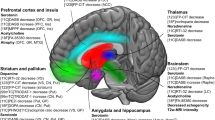Abstract
There are several problems related to the diagnosis and the biochemical background of depression in patients with Parkinson's disease (PD). The most important problem is how do we understand depression in PD. According to surveys using the diagnostic procedures specified in the Diagnostic Statistic Manual-III or IV, the prevalence of depression is 20–40 % in PD. However, the reported rate varies according to the composition of the subject group and whether or not a control group is used, so it is still controversial whether a figure of 20–40 % reflects the actual prevalence of depression. Latest studies showed about 2–8 % of PD patients are diagnosed with major depression by DSM-III-R. These recent studies suggest that major depression and PD may coexist and dysthimic disorder may be an essential feature in PD. With regard to the neurochemical background, the level of 5-hydroxyindoleacetic acid (a major metabolite of serotonin) is reduced in the cerebrospinal fluid suggesting that serotonergic dysfunction exists in the brain of PD patients. However, there is no high quality evidence to indicate the effectiveness of selective serotonin reuptake inhibitors for depression in PD. Autopsy studies have revealed that not only serotonin, but also dopamine, noradrenaline and other neurotransmitters are reduced in the brains of patients with PD. Accordingly, treatment may become difficult in many cases due to these changes of multiple neurotransmitters. Development of a better treatment strategy based on improved understanding of the neurochemical background is needed.
Similar content being viewed by others
Author information
Authors and Affiliations
Rights and permissions
About this article
Cite this article
Yamamoto, M. Depression in Parkinson's disease: its prevalence, diagnosis, and neurochemical background. J Neurol 248 (Suppl 3), III5–III11 (2001). https://doi.org/10.1007/PL00022917
Issue Date:
DOI: https://doi.org/10.1007/PL00022917



